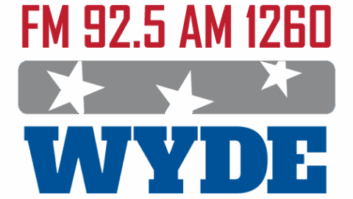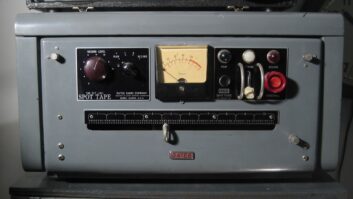Barry Thomas remembers the smell: a romantic mixture of history, technology and tobacco.
“There was this weird mix of 1940s dust from the Harris boards and Gates transcription turntables, kicked-up dust and this slight tinge of nicotine. “It felt huge.”

He was a teenager, doing newsbreaks on a little disco-formatted, automated AM that ran in a back closet of a TV/FM/AM combo. He’d been allowed on the air because he had “an awful cold that gave me a little rumbly voice.”
But 32 years later, and still not yet age 50, he has built his career working not behind microphones but inside equipment racks, under studio countertops and at conference podiums. He also is among radio’s most vocal advocates — on Capitol Hill, at convention panels and in standards discussions — for radio and for the engineering profession.
Barry Thomas, CPBE CBNT, vice president of engineering for Lincoln Financial Media, is the recipient of the Radio World “Excellence in Engineering” Award. Recipients represent the highest ideals of the U.S. radio broadcast engineering profession and reflect those ideals through contributions to the industry.
Industry service
His résumé is rich with technical accomplishment in all manner of environments. That includes supervising tech operations for radio groups, and directing engineering work in support of national radio news bureaus and coverage of political conventions and Olympic games. He has built studios, moved stations, created engineering departments and designed satellite networks.
But perhaps even more impressive to me has been his role in national technical organizations. When issues of importance involving radio engineering are being debated, you can be sure to find him nearby.
He served two terms as president of the Society of Broadcast Engineers and chairs its Government Relations Committee. He has been active in support of legislation to allow FCC commissioners to add engineers or computer scientists to their staffs.
The SBE this year elected him Fellow, a designation that recognizes members who have rendered conspicuous service or made valuable contributions to the advancement of broadcast engineering.
He also is active in the National Radio Systems Committee, the influential standards body co-sponsored by the National Association of Broadcasters and the Consumer Electronics Association. He chairs the NRSC RBDS Subcommittee. Barry also serves on NAB’s FASTROAD and Engineering Conference Committees.

At the WNOK(FM) transmitter site in the 1980s. ‘I was the assistant engineer when this site was built, but I moved and rebuilt the former main transmitter, an RCA BTF-10e1, to be the aux. This was the STL/monitor/processor/exciter rack between the main and aux transmitters. I was proudly standing by our new 8100Xt2.’
Hail, Columbia
In those early days at WNOK in his hometown of Columbia, S.C., he eventually did just about every task at the station, including engineering, production, morning show support, oldies PD and sales. Later he helped build a new 100 kW station in the Hilton Head area.
He rattles off a list of people who assisted him, particularly early in his career.
Peter Hamlett helped Barry obtain radio interviews and cordially tried to talk him out of a career in the business. “He taught me from a customer service perspective. He taught me the fun of radio and the excitement of doing the work.”
Engineer Bob Byrum entrusted an AM station to the young engineer. “I made all kinds of messes and had to clean them up. He was the person who taught me my craft, the math, the nuts and bolts.”
Local engineers Fayne Anderson and Milton Holliday shared time and knowledge, as did Bobby Lambert, a former FCC inspector, and contract engineer Alan Hovermale.
Barry met Tony Gervasi, hired him as an assistant and was best man at his wedding. Cross-town engineer Ed Noyes, currently a Citadel/Cumulus engineer in the market, was a staunch processing competitor. “We’d meet at Lizard’s Thicket, where everything’s deep fat fried, for lunch and we’d say, ‘I made a change last night, go figure out what it is.’” Radio exec Bill McElveen, then at Audubon Broadcasting, was supportive.
His career took Thomas to Cleveland as chief engineer of WPHR(FM), which later became alternative, WENZ. “Paul Donahue at Gannett told me, ‘You’ve got an opportunity to work in Cleveland, you need to go.’ Boy was he right. Paul was trying to tell me there were these talented people and you’ll learn what you won’t learn anywhere else.”
Thomas soon became DOE for OmniAmerica Group of Cleveland and stations WMJI(FM), WMMS(FM) and WHK(AM).
“It was a competitive market, a fierce market; yet the stakes weren’t so high you couldn’t make a mistake. You can’t make a mistake in San Francisco or New York.” He recalls the confluence of talent and events in the mid-1990s as a magical one. Cleveland saw the opening of the Rock and Roll Hall of Fame and Museum and Jacobs Field; the Indians went to the World Series. Thomas worked with or got to know industry figures like Dean Thacker, Carl Hirsch, John Gorman and Chriss Scherer.
“I ended up working in the footsteps of Steve Church and Frank Foti. Everything they’d left at the transmitter site of WMMS/WHK — you could see these old Cutting Edge or Telos frames there. … ‘Ooh, this is where Carl Smith taught his classes.’ Then you get a chance to meet Carl Smith.”
Broad body of work

Thomas tweaks the loading on the Harris FM25K at WENZ(FM) in Cleveland.
Eventually the West Coast called.
Thomas became a station technical director for AMFM/Chancellor Media in the late 1990s, a time of infrastructure change in the industry after the easing of ownership caps. Around this time, Chancellor and Evergreen Media merged to become AMFM Broadcasting, which later would be purchased by Clear Channel.
Barry headed a staff of engineering directors from Evergreen and Chancellor in constructing facilities in San Francisco and Los Angeles. He recalls a period of 12 months in which the team performed two station moves, a station buildout and a major swap of transmitting facilities (changing KYLD from 107.7 to 94.9 MHz). Another big project, building KCMG(FM), “Mega 100,” let Thomas move to Los Angeles, one of his career goals.
The early ’00s saw him directing engineering at dot-com firm Comedy World Radio Network, including design of its studio and office facility for radio, video and Internet publishing. Then, as VP of engineering for Westwood One Radio Networks in New York, he directed network operations, maintenance and affiliate tech support for the country’s largest radio network, and managed tech support for the likes of Bill O’Reilly, Tom Leykis, Jay Severin, Jim Bohannon and Lars Larson.
Among further accomplishments, Barry has worked as a contract engineer in Ohio and California. He helped found StratosAudio, an interactive radio technology company, and worked there as chief technology officer. He assisted in the launch of SBE Chapter 101 in South Carolina, sold gear for dealer Broadcasters General Store and has had a hand in three patents.
Since 2006 he’s been VP of engineering at Lincoln Financial Media, formerly part of Jefferson-Pilot Corp. It currently has 14 stations. He is based in Atlanta and oversees engineering and IT, reporting to CEO Don Benson.
Their own enemy?
“Against all odds, I’m still really excited about what’s ahead for radio broadcasting,” Barry told me. “Broadcasters, and particularly programming professionals, still are very good at what they do.”
While a platform like Pandora may grow, “Group sourcing of musical taste is only good to a point. People still appreciate professionals making music decisions for them, being presented with a product. … The killer app for radio is the professional programmer.”
Yet broadcast engineers have a key role. He likens it to being on the shop floor in a car factory. “We don’t necessarily design the car. We ideally have input; but really skilled and talented design people come up with the design, really skilled sales people sell it. It’s our job to make that thing.
“You give me an exciting design, and I just love making that car.”
Barry Thomas feels engineers in general do themselves a disservice.
“We are so customer service-oriented, we allow ourselves to be taken advantage of a great deal. We [also] tend to devalue our own skill set. We devalue the importance of our role in the enterprise.”
The old “engineer stereotype” shouldn’t apply anymore, he said; yet even engineers still fall into that mindset. “I’ve really made an effort throughout my career to be part of the management and programming teams.”
And the radio product does excite him. You can sense a lifelong love for the medium in his voice.
“It’s still magic on the airwaves. I listen to talk radio: Rush, Neal Boortz, Rachel Maddow. You hear good programming, something that draws you in …people still gravitate to that. In music, too. It’s presentation. The music is not the product; the presentation and the lifestyle are the product.”

On Capitol Hill, lobbying for legislation to strengthen the technical expertise of the staffs of FCC commissioners.
He’s further excited by what radio groups are doing with streaming, citing Clear Channel’s New iHeartRadio as an example — “They are injecting streaming radio with professional programmers; I think that’s going to be very interesting to see” — but he thinks this trend also will leave holes in individual markets. “When I want to hear about Los Angeles, I go to stations that have that lifestyle, that tell me about that region. When you have national brands, like Clear Channel, you leave holes for local brands.”
Remission
If you know Barry Thomas personally, you are asking yourself, “But what about his health?”
In 2008, concerned about a persistent crick in his neck, he sought medical advice. He was diagnosed with multiple myeloma, a cancer of the plasma cells in bone marrow.
“It had degenerated one of my vertebrae. Incredibly fast it went from, ‘Hmm, what’s that little mass,’ to ‘They can’t see the outline of the vertebra on the X-ray.’”
He went through emergency spine surgery, involving a fusion and titanium rods. (“I walk around looking like the Muppet Sam the Eagle.”) In the course of that he also started going through chemotherapy. “The treatment was a combination of oral and intravenous meds; and at the same time they’re harvesting stem cells. At the same time my wife is pregnant with her second set of twins.” In a short span he went through four courses of chemo as well as the stem cell harvesting; and his sons were born.
Today he receives infusions every eight weeks, with blood tests and checks every four. Usually he feels pretty good, he told me, though recovery weeks are harder physically due to the treatments. He has to fight fatigue and find more time to rest. Also, “I don’t wish the diet program on anyone!”
Now the cancer is in remission. “The counts are zero. Whatever started has stopped.” Thomas sounds upbeat, saying life expectancy for people with his condition has gone up dramatically, and adding that he’s appreciative he can go about his life’s duties.
“If you look how others have responded … the fact I can function and work a full-time job and be a father, it’s a miracle itself.”







